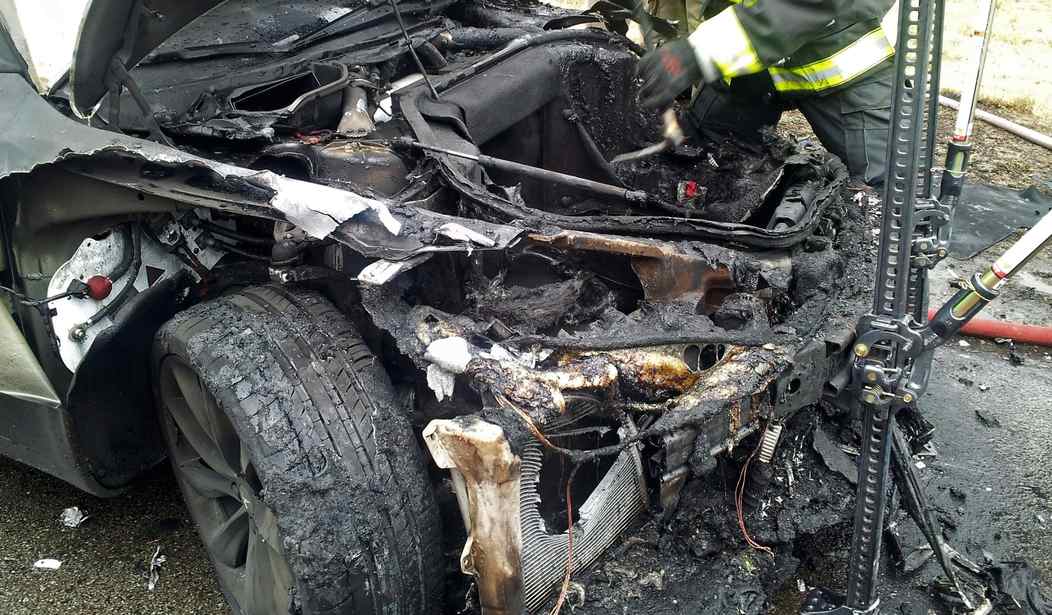It is now, or should be, common knowledge that electric vehicles—cars, trucks, buses, bikes, scooters—under conditions of even low humidity or water damage, are prone to catching fire, owing to the unstable nature of the lithium-ion battery. As Chris Morrison writes at The Daily Skeptic, EVs are known to explode “with the force of a bomb blasting super-heated jets of flame, melting and decomposing nearby structural materials including metal and concrete, and sending vast amounts of toxic fumes into any enclosed atmosphere.”
Exploding with the force of a bomb blasting 2,000°C super-heated jets of flame into surrounding areas, EV fires have risen 46% in just a year. No wonder the public are turning against them, says Chris Morrison. https://t.co/zZ671BcTpD
— Toby Young (@toadmeister) September 26, 2024
Jammed into underground parking garages or packed in ferries, EVs are harbingers of almost unimaginable disaster—ecological and safety menaces to which the Net Zero fanatics among our political leadership are comatosely indifferent.
We have witnessed lethal battery explosions in South Korea and elsewhere with significant loss of life. QBE Europe reports that such fires are increasing at a worrisome rate and explains: “Lithium-ion fires are the result of thermal runaway, where batteries start to irreversibly overheat, usually due to impact damage, over-charging or over-heating... The resulting explosive fire incidents are significantly more energetic [than ordinary fires], causing extensive damage, and potentially injury or even death.” They cannot be readily put out and will often re-ignite.
We read of an electric truck loaded with lithium batteries catching fire, closing down the Port of Los Angeles, Long Beach, and the Vincent Thomas Bridge. We learn that Audi’s signature e-tron GT has been recalled multiple times over fire concerns. A massive fire at a Rivian Plant crisped over 50 vehicles. In 2022, Hurricane Ian caused 20 electric cars to catch fire “after they flooded with salt water, creating hazards for first responders.” We have seen the damage that Hurricane Helene caused in Florida and other states, involving the volatile nature of EVs as well. According to Florida Politics, “Gov. Ron DeSantis urged owners of electric vehicles in Florida on Wednesday to drive them to higher ground to avoid them being exposed to seawater.” A Toronto apartment complex has just banned all electric vehicles, including electric bikes, motorbikes, unicycles, hoverboards, mopeds, Segways, skateboards, and scooters, citing fire risk. These are only a few of the instances that are on record.
It is to be expected that EV advocates—government officials, industry executives, interested buyers, and committed owners—will claim that internal combustion fires far outnumber their electric competitors, which does make statistical sense. There is significantly more of one than of the other. According to various reports (e.g., International Energy Agency, Regie de l’énergie du Canada, etc.), EVs make up anywhere from only 5 percent to 18 percent of the market, depending on the country. In any case, it is a sales number that is now markedly declining as consumers and major companies are turning off EVs.
As I have previously pointed out, Ford Motors is backing away from EVs and reconditioning an EV plant to build high-demand Super Duty trucks. Nissan’s EV earnings dropped 99% in the first quarter of the year. General Motors delayed (perhaps indefinitely) the new Buick EV and a new electric truck factory. Hertz Global Holdings is selling off 20,000 EVs from its fleet. The Financial Post reports that Volkswagen has cut EV output in Germany as demand craters. Indeed, The Telegraph reports that Germany suffered a “spectacular 70pc drop in electric car sales.” EV automobile manufacturer Stellantis has laid off thousands of Michigan workers. Italy has called for a review of the European Union’s coming internal combustion car ban, claiming that the “absurd” policy was ideologically driven and ignored the realities of the market.
But even if this were not so, EVs would continue to pose a much greater danger than ICE vehicles. I have only seldom heard of a gas-powered vehicle aflame, yet EV fires seem to be a regular event, giving off clouds of toxic emissions and burning almost uncontrollably. They are a source of ecological havoc whose effects will grow increasingly evident despite government mandates and media silence.
Although I have written about the EV hazard on several occasions for this site and others, the issue's implications recently came home to me with renewed force. Embarking on one of the myriad ferries that ply between Vancouver, the Sunshine Coast, and the Gulf Islands, I noticed a late-model EV among the hundreds of cars, trucks, and tankers making the crossing. There were certainly more, but one was enough to get me thinking. A single “thermal event” would cause a near-unquenchable fire, release volumes of toxic emissions, and set off explosions in the confined hold of the ship that would likely result in its foundering and the death of many passengers from fire, poisonous fumes, and drowning.
This was a nightmare vision that I sensed would one day translate into the real world. I also knew that very few of the officials in charge of the ferry service would accept the very real possibility of such a cataclysm. If such an event should occur, denial and subterfuge would be the response. The cause would have to be located elsewhere. The combination of inertia and vested interest, bureaucratic sluggishness, and profiteering avarice would constitute nothing less than criminal indifference.
I was encouraged to read that the Norwegian shipping firm Havila Kystruten, which operates car ferries around the coast of Norway, has banned the transportation of electric, hybrid, and hydrogen vehicles. And with good reason. Neil Dalus of the freight insurer TT Club points out, “During a lithium battery thermal runaway event... significant amounts of vapour can be produced in many common supply chain scenarios, including ships’ holds and warehouses.” The potential toxic effects, as noted, can be and have been fatal. “Drivers, stevedores, ships’ crews and first responders attempting to control the blazes encounter what might appear to be smoke but is in fact a mix of toxic gases, generated quickly and in large volumes.” The freight insurer warns that the failure of these batteries can occur “with such speed that there is typically no time to react.”
Such disasters may not be as improbable as we may have thought. They are just waiting to happen. Mike Gallagher, CEO of Ports Australia, warns of the ferocity of such fires: “You can’t put them out. So you can imagine it on the street if you can’t put them out, imagine them on a vessel out at sea or in a port.” In 2022, the Felicity Ace, a large cargo vessel carrying 4,000 cars, including EVs, not-so mysteriously caught fire and sunk. In July 2023, the Dutch vessel Freemantle Highway, with a cargo of 3,783 vehicles, including 498 EVs, burst into flames, the fire starting “in the battery of an electric car,” according to a crewman.
Watts Up With That worries that “ships and their crews continue to risk their lives transporting unstable forms of Lithium such as finished Lithium batteries, to help green politicians maintain the fiction they are reducing CO2 emissions.” The National Transportation Safety Board has also advised of the inherent risks. EVs are ticking time bombs.
Of course, engineers and technicians are working to improve the safety co-efficient of the lithium battery, but success is years in the future—if at all. Moreover, the electrical grid cannot sustain the drain on its capacity, which in itself is enough to put paid to so ill-advised a project. Whatever way we look at it, the EV revolution is premature and appears destined to failure. One should keep in mind that many professional firms and the media will almost always gloss over the danger and the lethal radius of these fires in the same way that “fact-checkers” almost always manipulate rather than check the facts. Believe them at your peril. The risk factor is not susceptible to standard data analysis.
Indeed, the purring statistical distributions we find all over the Net with respect to the comparative dangers of driving an EV and an ICE vehicle, assuring us we have no need to worry about EVs, depend on a selective approach to weak or imperfect data arrays. The statistical apparatus that is usually brought to bear upon the events in question is not only starved of appropriate data but is meant to distort our perception of the situation. It cannot accommodate the scalene and empirical properties of certain sorts of phenomena—in this instance, what we might refer to as “crisis events.” One EV fire can sink a ship; the damage is incalculably greater than any number of regular vehicles can give rise to. How do we compute so disproportionate a probability? We are dealing with a category error. One apple, so to speak, may be far more septic than innumerable oranges. As the old saw goes, “Do not put your faith in what statistics say until you have carefully considered what they do not say.”
"Companies flourish in a free market economy not by serving bureaucrats but consumers, the true ‘bosses,'' writes Jonathan Miltimore at The Epoch Times, condemning the “hamfisted” misallocation of government resources. “Fortunately, the centrally planned EV Revolution now appears dead in the water, or at least in full retreat.” One hopes he is right. Although governments everywhere continue to push for increased “adoption,” the time has plainly arrived to end EV mandates, wasteful government subsidies and incentives, and the political, corporate and media propaganda campaigns leading to the inevitable economic, ecological and life-threatening debacles everyone will come to regret. The time is now, before the treasury collapses and the fatalities begin to mount up.










Join the conversation as a VIP Member